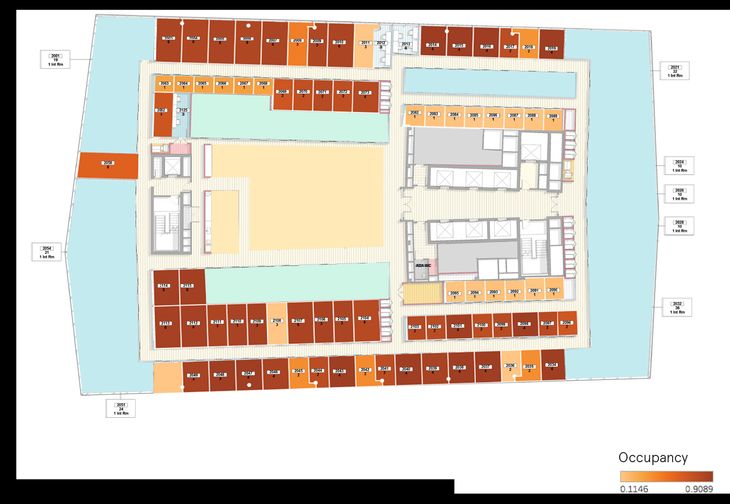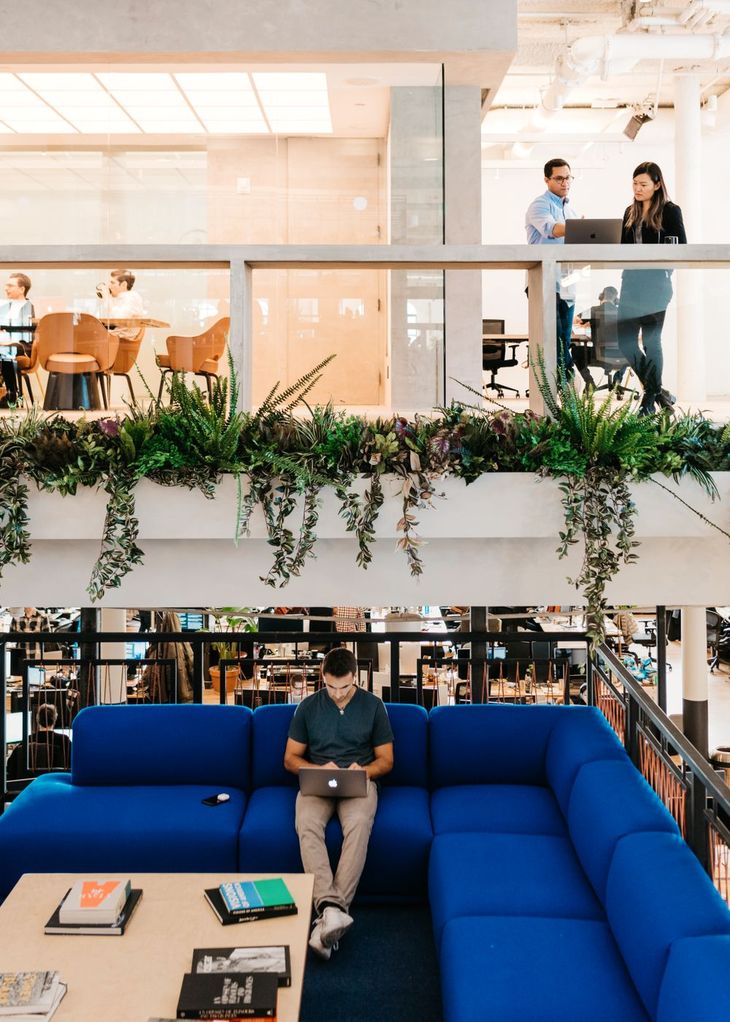Cite as: Davis, Daniel. 2019. “Vertically Integrated Research: An unusual business model.” Architectural Design 89 (3): 68–75.
Architects rarely get the opportunity to systematically analyse the consequences of their design decisions. ‘Because our heuristic seems to be “Never look back”, we are unable to predict the longer term consequences of what we design,’ writes Frank Duffy1. Given that buildings cost millions of dollars, consume vast quantities of resources, and greatly impact people’s overall happiness and productivity, it seems odd that designers so rarely return to past projects in order to learn from previous successes and mistakes. This dearth of research could be attributed to many things – a lack of money, tools or, motivation – but fundamentally it is the industry’s business model that seems to inhibit architects from more regularly studying past work.
WeWork has a different business model from most architecture firms. It designs spaces, constructs them, and rents them out for a monthly fee. In effect, WeWork is a vertically integrated company, with design, construction, sales, and building operations all performed in-house rather than being contracted to separate entities.
WeWork’s organisational structure may seem like an implementation detail more pertinent to business people than to researchers, but it is a critical detail since the structure of a business impacts the value of research. At WeWork, business and research are intertwined – you cannot have one without the other. In particular, there are three aspects of WeWork’s research that depend on its vertical integration: (1) being able to rapidly contact thousands of users; (2) being able to generalise research findings across a portfolio of related projects; (3) being held financially accountable to the performance of design concepts. By understanding how business structures enable research, it may be possible to overcome some of the barriers that architects encounter when trying to integrate research into their practice.

WeWork, Dalian Lu, Shanghai, 2018.
Most WeWork locations feature a similar combination of programmatic elements. In this Shanghai location, a lounge space is framed by a row of meeting rooms (left) and a communal kitchen (right).
Knowing the User
If you do not know who uses your project, you cannot study how your design choices affect them. Designers may have hunches or intuitions, but to truly understand what is happening you need to get in there and observe or interview people.
For many architects, the end-user is something of a mystery – an anonymous person separated by layers of intermediaries. These intermediaries naturally arise as the project passes through the many entities typically involved (the architect hands the design to a contractor, who delivers it to a developer, who gives it to a broker, who sells or rents it to the occupant). By the end of this process, the user is so many times removed from the architect that the architect normally does not know the inhabitant’s name, let alone anything about how they are using the space. Even in the best-case scenario, where the client is also the end-user, the architect meets with the client early in the process but it is rare that a client wants to continue seeing the architect after the space is completed. Thus architects more often than not find themselves on the other side of the walls they build, unsure of what is happening behind closed doors.
There are, of course, instances where researchers have gained access to people in private spaces. Leon Festinger studied students in college dorms2, Jeanne Arnold et al created an intimate portrait of families living in LA3, and a small number of architecture firms revisit their buildings to conduct post-occupancy evaluations4. But these studies are the exception. Most of the research on people interacting with the built environment takes place in public spaces where people are more easily observed and where the disconnect between the architect and the user is not as pronounced (think: Jane Jacobs’s observations of great American cities5, William Whyte’s studies of pedestrians in New York6, and Jan Gehl’s research on the life between buildings7).
WeWork knows all the people using its spaces. There are no particularly sophisticated tools or tricks to gain access to these people. Instead, it is a simple byproduct of WeWork’s business model. Since WeWork is both the designer and the owner of their spaces, there are no intermediaries between WeWork and the people using the spaces – the occupants pay WeWork directly and WeWork is entirely responsible for their experience.
Compared to the advances that other researchers are making with algorithms, data models, and related technologies, knowing an inhabitant’s name and email address may seem like an insignificant development. But for researchers at WeWork, knowing the occupant's name enables a type of investigation that would be unimaginable in a typical architectural setting. Researchers have, for instance, studied the emotional impact of aesthetic choices by surveying tens of thousands of people in hundreds of different work settings. They have asked people from around the world to take photographs of their desks, of their lunch, and of their favourite workplace, which has produced an intimate glimpse of workplaces in different cultures. They have interviewed dozens of new mothers about their experiences using lactation rooms. And they have asked people to name their closest work friends in order to understand how spatial decisions impact social networks (a revised version of Festinger’s seminal dorm-room study8). It is incredibly useful information for designers that becomes easy to gather once you know the names of the people using your spaces.

WeWork, WeWork portfolio, 2018.
80 floorplates from the 280 buildings in WeWork’s portfolio. These buildings are similar enough to compare but different enough to have a variety of outcomes, providing researchers with a Petri dish of locations to study.
The Hidden Cost of Originality
Another challenge of studying the built environment is that every building is unique, which makes it difficult to use findings from one project to the next. That is to say, even if you learn something insightful on one project, it’s not always clear whether these lessons will translate to a new building with a different client, a different site, a different layout, and a different programme.
This has become especially difficult in recent years, with a number of architects showing a stylistic aversion to anything repetitive. Taken to its logical extreme, designers have embraced parametric modelling as a way of generating buildings where not only is the building unique, but every element inside the building – including floors, windows, and columns – are themselves unique, one-off, and original. All of this novelty has a hidden cost: in a world where everything is bespoke, and every variable is in play, it becomes increasingly difficult to find commonalities and truths that are applicable across projects.
Each WeWork location is a unique design specific to the site conditions and the local culture. The designs are created by a team of interior designers, architects, engineers, artists, and other specialists who follow a global style guide that they modify to fit the local context. With over 280 locations open, the result is a collection of buildings that each have their own personality while sharing a common DNA. These buildings are similar enough to compare to one another but different enough to learn from each of them.
In a recent project, researchers at WeWork attempted to predict which offices would be the most difficult to rent. The designers at WeWork suspected that rooms with windows would presumably be easier to rent and that rooms beside bathrooms or with awkward internal columns might be harder to rent. The researchers analysed the spatial features of thousands of offices in the WeWork portfolio and combined these with sales data for each room. Applying a form of machine learning called support vector classification, the researchers were able to determine, with around 60–70 percent accuracy, the spatial features of an office that makes it difficult to rent9. WeWork’s revenue optimisation team then incorporated the most salient features into their pricing model, allowing WeWork to identify, price, and remedy poorly performing offices before they are constructed.
Comparing thousands of offices would not be possible if they all had unique furniture, finishes, and layouts. Because the WeWork offices follow a common design language, the offices have enough similarity to make this type of research viable. The researchers can also be confident that their results are generalisable since they are observing these patterns in dozens of buildings rather than taking anecdotal lessons from individual projects. In many ways, this requires thinking more pluralistically about projects – instead of treating every project as an individual experiment, it is a portfolio of projects that become the experiment.

WeWork, Likelihood that people will rent offices at WeWork Moorgate, London, 2017.
Using past sales data, the research team was able to develop a machine-learning model that predicted the likelihood that an individual office will be rented with around 60–70.
Skin in the Game
In many respects, architects are paid to look forward, to imagine what our cities might look like many years into the future. They are rarely paid to look back.
The make or break point for any architect comes early in the project. The architect has to convince the client (whether through a competition, a bid, or just a lot of charm) that their vision of the future is worth building. Beyond this point, unless something goes catastrophically wrong, they have limited financial exposure to the success of the project – just look at the number of projects that run over budget and behind schedule10.
Because WeWork is vertically integrated, if a project is delivered over budget, WeWork is liable for the expense. If a project is delivered late, WeWork has to rehouse hundreds of people who were expecting it to be open. And if a project does not perform as expected, WeWork is stuck with offices that are difficult to rent.
Since WeWork’s business depends on consistently delivering high- performing projects, its employees are naturally invested in the outcome of their projects. Quite often architects and designers conduct their own investigations, gathering data on how particular spaces are used, analysing feedback they have received, talking to people running locations, and walking through projects making their own observations about how people are using the space. These are not necessarily formal research projects, but there is a culture of curiosity and experimentation. Just like any other research project at WeWork, these informal studies benefit immensely from being able to contact users and to generalise findings across a portfolio of related projects.
Given the hunger for performance, people at WeWork are generally receptive of research. The research is typically distributed to teams working on design standards, design processes, and the creative direction, which then makes its way into the wider design process. The research is also shared with other employees in the form of written reports, presentations, a newsletter, and a podcast. At times researchers encounter impediments that are common at large companies – sometimes the business moves faster than the researchers, sometimes researchers study the wrong thing, or find nothing of interest, or find that it is too expensive to implement findings. At times, researchers have also found themselves under a lot of pressure given the high-stakes nature of WeWork’s vertical integration (in an academic context, a mistake may be caught by a peer reviewer a few months later, but at WeWork the research is applied almost immediately and any mistake can have real consequences). Despite all of this, WeWork’s researchers have influenced everything from the design of lactation rooms to the placement of stairs, the function of office furniture and the quantity of meeting rooms. It is research that happens primarily because WeWork’s business model makes everyone invested in the performance of the projects.
Building on Research
Every architect is a frustrated scientist. They spend years developing hunches about what makes a building successful. They form hypotheses, convince clients to spend millions funding their experiments, and watch their creation rise from the asphalt, crossing their fingers and hoping the building functions as intended. But once the building opens, once it comes time to gather the results from this experiment, architects often find themselves shut out, unable to measure whether their design functioned as intended. The industry being what it is, architects rarely return to their previous work to systematically analyse the consequences of their design choices.
For the most part, the industry’s resistance to research is deeply rooted in the institution. It is an intuition that rarely measures results, that canonises and celebrates individuals who have shown great intuition, that teaches students to design using concepts rather than evidence, and that looks to the future while paying little attention to the present. That said, even if firms were able to conduct research more regularly, most firms do not have the infrastructure to capitalise on the results because they still live and die on their ability to win work instead of the performance of their projects. For this reason, research is not something that can be simply added to practice, but rather something that necessitates rethinking the way we practice altogether. Research needs to be part of the business model, not an accessory added to it. For WeWork, that business model is one of vertical integration, which enables research that incorporates thousands of people, that generalises across projects, and that is tied to the financial success of the company.
Postscript: I wrote this article in 2018 when WeWork was on a seemingly unstoppable upwards trajectory. Everything fell apart the following year. The company tried to IPO and failed, the CEO was ousted, thousands of people were laid off (including myself), and the research team was effectively dismantled. Looking back on it, the article's final line, the one that says research is 'tied to the financial success of the company', feels like something I'd like to underline a hundred times.
Notes
1:Frank Duffy, Work and the City, Black Dog Publishing (London), 2008, p 12.
2:Leon Festinger et al, Social Pressures in Informal Groups: A Study of Human Factors in Housing, Harper (Oxford), 1950.
3:Jeanne Arnold et al, Life at Home in the Twenty-First Century: 32 Families Open Their Doors, Cotsen Institute of Archaeology Press (Los Angeles), 2013.
4:Bill Bordass et al, Probe Strategic Review 1999, Report 4: Strategic Conclusions – Get Real About Building Performance, The Probe Team (London), 1999: [http:// www.usablebuildings.co.uk/Probe/ProbePDFs/SR4.pdf](http:// www.usablebuildings.co.uk/Probe/ProbePDFs/SR4.pdf).
5:Jane Jacobs, The Death and Life of Great American Cities, Random House (New York), 1961.
6:William Whyte, The Social Life of Small Public Spaces, documentary film, Project for Public Spaces, 1980.
7:Jan Gehl, Life Between Buildings: Using Public Space, Van Nostrand Reinhold (New York), 1971.
8:Festinger, op cit.
9:Carlo Bailey et al, ‘This Room Is Too Dark and the Shape Is Too Long: Quantifying Architectural Design To Predict Successful Spaces’, in Humanising Digital Reality, Springer (New York), 2017, pp 337–48.
10:Barry LePatner, Broken Buildings, Busted Budgets: How to Fix America’s Trillion-Dollar Construction Industry, University of Chicago Press (Chicago), 2008.
